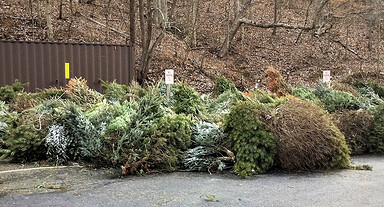Yuletide splash: recycled Christmas trees become fish homes
Savannah Halleaux
Washington Office
December 27, 2022
Used Christmas trees donated from nearby homes and businesses are consolidated and delivered to Wayne National Forest where they are repurposed to support aquatic habitats throughout the forest. (USDA Forest Service Photo by Ashley Kuflewski)
Harvesting and decorating a live Christmas tree is a holiday tradition in millions of U.S. households. Equally important and beautiful traditions surround taking down the coniferous holiday icon to recycle it for a second life and purpose.
The Wayne National Forest in Ohio has a particularly creative Christmas tree tradition: recycling local communities’ live Christmas trees to build homes for fish.
“We’ve been doing this project for several years – at least as long as anyone who works here can remember” said Ashley Kuflewski, district biologist for the Ironton Ranger District on the Wayne National Forest. “We work with some great partners, and we couldn’t do it without their help.”
To help local families contribute their used live Christmas trees, partners like Lawrence-Scioto Solid Waste Management District and local Lowes Home Improvement stores established collection points around Lawrence County, Ohio. After removing the ornaments, lights and adornments, families drop off their used live trees at the collection points.
Ohio Department of Natural Resources staff, Forest Service staff, and volunteers load tree bundles onto boats for transportation and placement in Lake Vesuvius in Wayne National Forest. (USDA Forest Service photo by Ashley Kuflewski)
The trees are then delivered to employees at the Wayne National Forest, where they receive and process between 300 and 600 trees every year. Forest Service employees and volunteers prepare the trees by drilling holes in the trunks and tying them together in bundles of two or three.
On sinking day, employees from the Ohio Department of Natural Resources, Division of Wildlife, bring boats for loading and transporting the tree bundles to their final aquatic resting place. A cinder block is attached to the base of each bundle as a weight to anchor the tree to the lake or river bed.
“The trees help us get a good habitat going with lots of different species,” said Kuflewski. “That makes great large game fishing for the public.”
The trunks and branches of recycled trees add structure and complexity to the lakebed habitat in which small fish can feed and hide from predators. As the branches decompose, they grow beneficial algae that attract and feed zooplankton. The zooplankton and algae in turn feed mussels, snails, and crawfish that feed catfish and small baitfish. The small baitfish nourish and attract large gamefish for recreational and sustenance fishing for forest visitors.
Bundles of recycled Christmas trees are placed in Timbre Ridge Lake in Wayne National Forest by Forest Service staff and Ohio Department of Natural Resources staff to create habitat for beneficial algae, zooplankton, clams, mussels, snails, crappie, bluegill, and largemouth bass. (USDA Forest Service photo by Glenn Finley)
With community support and a post-yuletide splash, new aquatic homes are established each winter for local flora, fauna, and fishermen to enjoy for years to come.
This is one of the many Forest Service traditions for meaningfully repurposing Christmas trees. Ruby, the 78-foot-tall 2022 U.S. Capitol Christmas Tree, will become musical instruments such as guitars and banjos for donation to local communities. Sugar Bear, the 84-foot 2021 U.S. Capitol Christmas Tree became serving trays and lumber for picnic tables. Others, like as with most municipal tree recycling programs, were turned into mulch to benefit the diverse flora of local urban landscapes.
To find resources for locally recycling or repurposing your Christmas tree, contact your local municipality to see if they offer a program. Other great resources for recycling trees are the National Christmas Tree Association and the Arbor Day Foundation.



